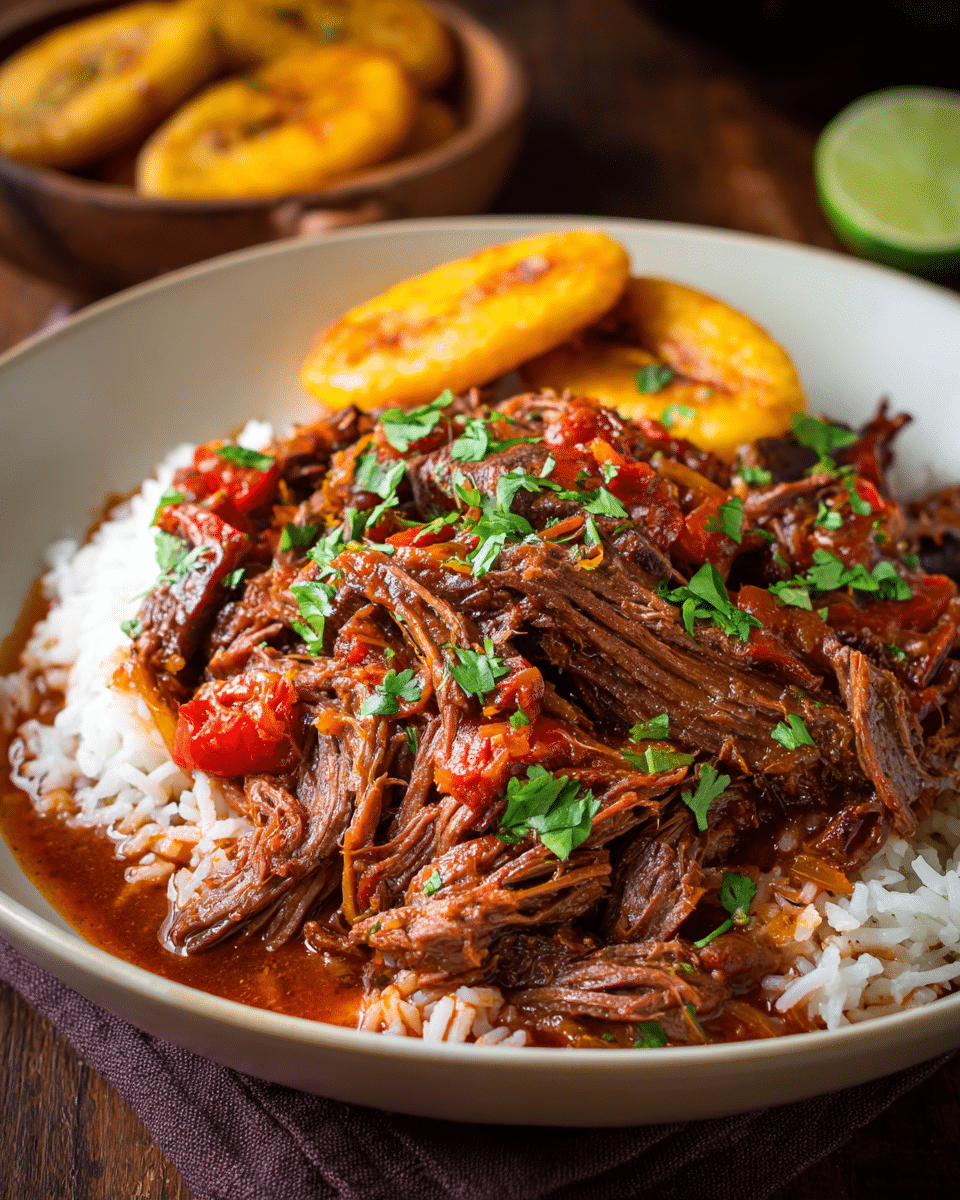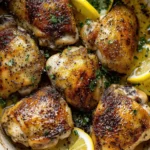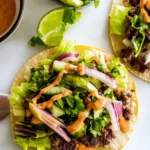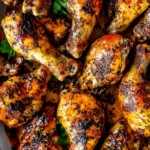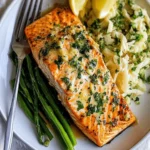Cuban Ropa Vieja, meaning “old clothes” in Spanish, is a beloved national dish of Cuba known for its tender, shredded beef simmered in a rich tomato-based sauce infused with bell peppers, onions, garlic, and Latin spices. Traditionally made with flank steak, this comforting dish gets its name from the meat’s thread-like texture resembling torn clothes. Served with rice, black beans, or fried plantains, Ropa Vieja is deeply savory, incredibly satisfying, and packed with soulful flavor.
FULL RECIPE
Ingredients
- 2 lbs flank steak (or skirt steak)
- 1 tbsp olive oil
- 1 large onion, thinly sliced
- 1 green bell pepper, thinly sliced
- 1 red bell pepper, thinly sliced
- 4 cloves garlic, minced
- 1 tsp ground cumin
- 1 tsp dried oregano
- 1/2 tsp smoked paprika
- 1/2 tsp ground black pepper
- 1/2 tsp salt (or to taste)
- 1/4 tsp crushed red pepper flakes (optional)
- 1/2 cup dry white wine
- 1 (15 oz) can crushed tomatoes
- 1/4 cup tomato paste
- 1 cup beef broth
- 2 bay leaves
- 1/4 cup green olives, sliced
- 1 tbsp capers (optional)
- 1 tbsp apple cider vinegar
- 2 tbsp chopped fresh cilantro or parsley (for garnish)
Directions
- In a large pot or Dutch oven, add flank steak and enough water to cover. Bring to a boil, reduce heat to low, and simmer for 2 to 2.5 hours until the meat is tender and shreds easily. Remove meat and shred with two forks; reserve 1 cup of the broth.
- In the same pot, heat olive oil over medium heat. Add sliced onions and bell peppers. Sauté for 6–8 minutes until soft and slightly caramelized.
- Add minced garlic, cumin, oregano, paprika, black pepper, salt, and crushed red pepper flakes (if using). Cook for 1–2 minutes until fragrant.
- Stir in white wine to deglaze the pan, scraping up any browned bits. Let it simmer for 2 minutes.
- Add crushed tomatoes, tomato paste, reserved broth, and bay leaves. Stir well to combine.
- Return the shredded beef to the pot. Stir in olives, capers (if using), and apple cider vinegar.
- Cover and simmer over low heat for 20–30 minutes, stirring occasionally, until the sauce thickens and flavors meld together.
- Taste and adjust seasoning as needed. Remove bay leaves before serving.
- Garnish with chopped cilantro or parsley. Serve hot with white rice, black beans, and plantains.
Nutrition Facts
- Calories: 410
- Protein: 37g
- Total Fat: 21g
- Saturated Fat: 6g
- Cholesterol: 95mg
- Carbohydrates: 16g
- Dietary Fiber: 4g
- Sugars: 7g
- Sodium: 780mg
- Potassium: 850mg
The Origins and Cultural Significance of Ropa Vieja
Ropa Vieja is one of Cuba’s most iconic dishes, with a rich history that reflects the island’s diverse cultural influences. The name, which translates to “old clothes,” is believed to refer to the shredded texture of the beef, reminiscent of tattered fabric. This dish traces its roots back to the Canary Islands, where a similar recipe existed before being adapted by Cuban cooks. It symbolizes comfort food in Cuban households and is often prepared for family gatherings and special occasions, representing both tradition and heritage.
Key Ingredients That Define Ropa Vieja’s Flavor
At the heart of Ropa Vieja is flank steak or skirt steak, prized for its flavor and ability to shred beautifully after slow cooking. The robust tomato-based sauce is enriched with bell peppers, onions, garlic, and a blend of spices such as cumin, oregano, and smoked paprika, which lend a warm, earthy complexity. The addition of green olives and capers introduces a subtle briny tang that cuts through the richness of the meat. Each ingredient plays a vital role in creating the dish’s unmistakable savory and slightly tangy profile.
The Slow Cooking Process and Its Importance
Slow cooking is essential to achieving Ropa Vieja’s signature tenderness and flavor depth. Traditionally, the beef is simmered gently for hours until it becomes soft enough to shred easily. This extended cooking time not only breaks down tough fibers in the meat but also allows the sauce to thicken and for flavors to meld perfectly. Using a slow cooker or a heavy pot with a low simmer replicates this effect, ensuring a juicy and succulent end result.
Variations of Ropa Vieja Around the Caribbean and Beyond
While Cuban Ropa Vieja is the most famous version, variations exist throughout the Caribbean and Latin America. In the Dominican Republic, for example, the dish often includes red kidney beans, adding heartiness and a different texture. Puerto Rican versions may incorporate annatto oil for a vibrant color and slightly nutty flavor. In some places, pork or chicken substitutes are used, adapting the dish to local tastes and available ingredients while maintaining the core concept of shredded meat in a savory sauce.
Health Benefits of Ropa Vieja
Though Ropa Vieja is a rich and hearty meal, it also offers several nutritional benefits. The lean flank steak provides a substantial amount of protein necessary for muscle repair and overall body function. The use of fresh vegetables like peppers and onions adds fiber, vitamins, and antioxidants. Moreover, the dish can be made healthier by controlling the amount of oil and salt used, and by serving it alongside nutrient-rich sides like brown rice or beans, making it a balanced and nourishing meal.
Serving Suggestions and Traditional Pairings
Ropa Vieja is traditionally served over white rice, which helps soak up the flavorful sauce and balance the dish’s richness. Black beans, fried plantains, and a side of yuca or mashed potatoes are common accompaniments that complement its textures and flavors. For a fresh contrast, a simple Cuban-style salad with tomatoes, onions, and avocado can be served alongside. These pairings not only enhance the meal’s authenticity but also provide a harmonious blend of tastes and nutritional variety.
Tips for Perfectly Shredded Meat
Achieving tender, shredded beef is a hallmark of Ropa Vieja, and there are a few tips to ensure success. Choosing the right cut is crucial—flank steak and skirt steak have the ideal grain and fat content. After slow cooking, it’s best to let the meat rest briefly before shredding to retain juices. Using two forks to pull the meat apart along the grain helps create the delicate “rag-like” texture. Avoid shredding too early, as the meat will be tougher if it hasn’t fully broken down during cooking.
How to Store and Reheat Ropa Vieja
Ropa Vieja keeps exceptionally well, making it ideal for meal prep and leftovers. Store the cooled dish in an airtight container in the refrigerator for up to 3–4 days. When reheating, do so gently on the stove over low heat to prevent the meat from drying out. Adding a splash of beef broth or water while reheating can help maintain moisture. It also freezes well for up to three months; thaw overnight in the fridge before warming. The flavors often deepen and improve after sitting, making leftovers just as delicious.
Ropa Vieja for Special Diets and Modifications
While traditionally made with beef, Ropa Vieja can be adapted for different dietary needs. For a lower-fat option, leaner cuts of beef or even shredded chicken can be used. To make it gluten-free, simply ensure that any broth or canned ingredients used do not contain gluten additives. Vegetarians and vegans can enjoy a plant-based take by substituting jackfruit or mushrooms for the meat, simmered in the same flavorful sauce, delivering the iconic texture and taste without animal products.
The Role of Ropa Vieja in Modern Cuban Cuisine
In contemporary Cuban cooking, Ropa Vieja remains a staple that bridges generations and culinary innovation. While some home cooks stick to the classic method, many chefs are experimenting with modern twists—such as slow-cooking in sous vide machines for precise texture, or pairing it with inventive side dishes. The dish’s enduring popularity speaks to its versatility and deep roots in Cuban identity, continuing to be celebrated in restaurants and households alike worldwide.
Conclusion
Cuban Ropa Vieja is much more than a simple shredded beef dish—it’s a flavorful symbol of culture, tradition, and comfort. Its rich history, vibrant ingredients, and tender meat combine to create a meal that warms both the stomach and the soul. Whether enjoyed in a traditional Cuban home or recreated with a personal twist, Ropa Vieja remains a delicious testament to the power of slow cooking and bold flavors.

